Airedale Terrier: description, content and popular nicknames

The Airedale Terrier is not one of the most popular and common dogs these days - this is one of the many reasons why you should choose this particular pet. Such a friend will turn out to be no worse than representatives of more popular breeds, but at the same time it will once again show that its owner is an original person, with non-trivial views on life, capable of having his own opinion, and not going with the flow under the influence of fashion trends. If you are already interested, you should get to know the Airedale better.
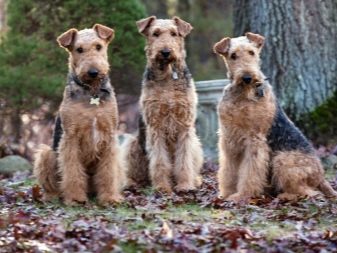
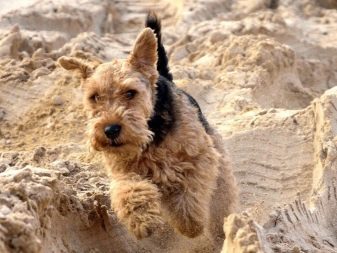
Origin story
It is curious that the Airedale and Yorkshire terrier are fellow countrymen originating from the same English county of Yorkshire, although they differ fundamentally in appearance. The breed got its name thanks to the Ayr River valley, where it first appeared. The dog owes its origin to the local workers, who bred it, crossing a red terrier (aka Welsh terrier) with a wire-haired Old English subspecies of black and tan terrier and an otterhound.
In 1864, the new dog first went to an exhibition, where it was sent by the then existing Airedale Breeding Society, although by that time the breed was not officially recognized and did not even have a standard name. At first, the new terrier was called either simply wire-haired, or coastal, or bingley, and the modern name was fixed only in 1879. Seven years later, it was under this name that the dog was officially included in the lists of the English club of dog lovers.
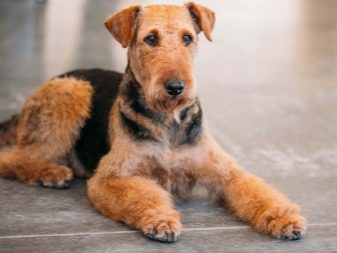
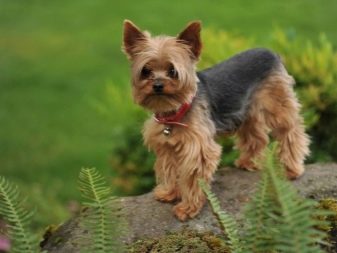
The place for breeding the new breed was not chosen by chance - throughout the century before last, the Ayr River valley was famous as the venue for regular sports competitions, which consisted of catching large river rats with the help of hunting dogs. For these purposes, relatively small dogs were used, capable of fighting the enemy directly on its territory, that is, in a burrow.
The Airedale turned out to be relatively large and did not crawl into holes, but, unlike most other terriers, it had an admixture from a hound, so it could pursue prey by smell, kill it on its own and bring it to the owner. Such activities required a lot of courage, strength and skill, so the dog quickly gained popularity among the "official" hunters and poachers, and soon began to be used also to guard farms or houses. To understand how quickly people appreciated a new breed, it should be clarified that the first dog went for export to the United States as early as 1880 - even before the breed was officially recognized.
The very first individual to arrive in a new country soon won a terrier show in New York.
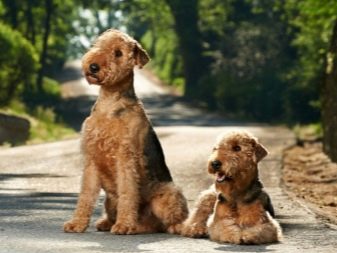

Already in 1904, the Russian embassy in Great Britain officially asked for help: they wanted to buy dogs that would help carry the wounded from the battlefield - just the beginning of the Russian-Japanese war. The British helped: they supplied terriers, mostly Airedales, and since then the breed has taken root in Russia.
For several decades, they were used as the main service dogs in various fields of activity. In 1906, Airedale Terriers were appreciated in their homeland - here they were recruited into the police force, where they initially accompanied the patrols involved in maintaining order in the ship's docks. It was these dogs that were chosen not only for their excellent instinct, but also for their excellent ingenuity and the utmost simplicity of caring for a hard coat.

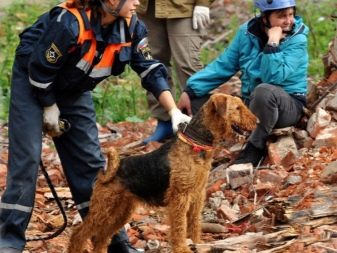
World War I took Airedale Terriers to the top of worldwide recognition - these first-class animals performed many important tasks, delivering mail, including behind the front lines, as well as finding the wounded and dragging them from the battlefield or bringing medical personnel to them. After the war, the wise and brave dog was overgrown with legends, its popularity increased immensely, because even several US presidents, including Theodore Roosevelt, Woodrow Wilson, Warren Harding and Calvin Coolidge, owned representatives of this particular breed.
Despite the impressive fame of these dogs, Airedales have never known mass distribution. For example, in the States, they reached the peak of their popularity in 1949, but even then they were included in only twenty of the most demanded breeds, which is not bad for the then list of 110 breeds, but does not allow us to talk about national love.
Today, even such indicators for Airedale terriers are completely unrealistic - they do not always even fall into the top 50.
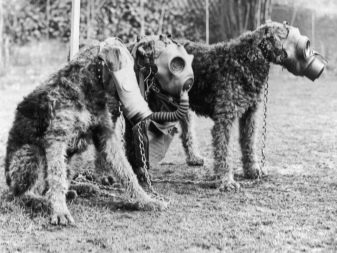
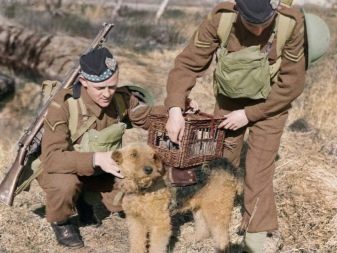
Description
Erdel's tongue will not turn to call it small - among his fellow terriers, he is rightly considered the largest. Compared to some other breeds, this dog may seem miniature - his height is 58–61 cm for males and up to 59 cm for females.
Although growth characteristics practically do not differ depending on gender, with weight, things are completely different - the male weighs 30 kilograms, while for his girlfriend 20 kilograms is already the limit. Naturally, the difference in weight with the same height affects the size of the torso - the girl looks like a mini-version of the boy.
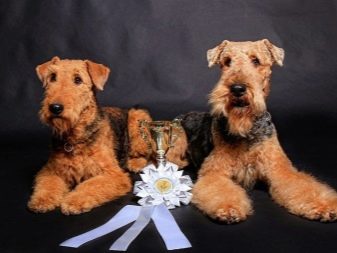
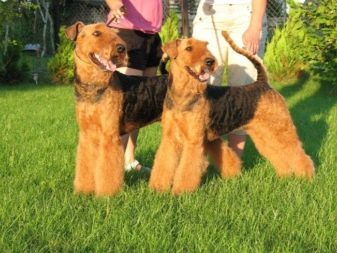
The standard assumes that the airedale's head is proportionally folded and narrow, elongated. There is no prominent forehead - it flows into the muzzle smoothly, without a sharp transition. The muzzle itself is rectangular, a significant part of its width is occupied by an elongated nose, black at the end.The lips are closely pressed against the jaws, which are characterized by high compression power and are dotted with large white teeth. Breaking out of the grip of such a dog is extremely difficult.
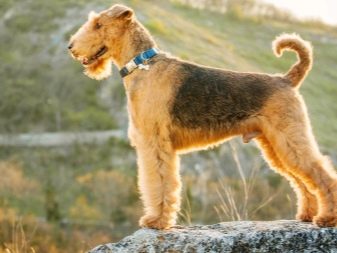
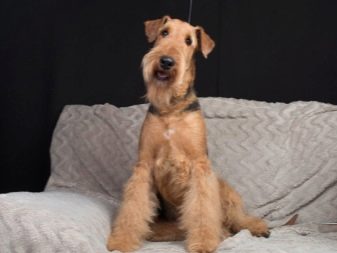
The dog has deep-set, round eyes, the shade of which can vary, but is always dark - close to dark brown or black. From the look of the dog it is already obvious that he is smart and perceptive. The ears are close together, small and triangular in shape, hanging halfway down, but still not limp.
The neck is not very long or thick, but it is muscular and strong. Strong build is also characteristic of the body of the dog. - it is square, has a reliable bone structure, a powerful back and a developed chest. A high-set tail is most often docked - in the original conditions of fighting the enemy, for which the airedale was created, it would only interfere with it. The body is carried on small, elongated strong legs.
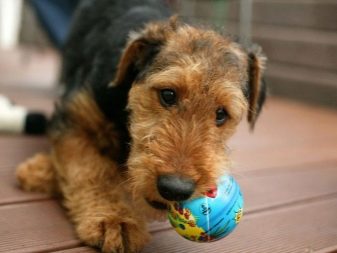
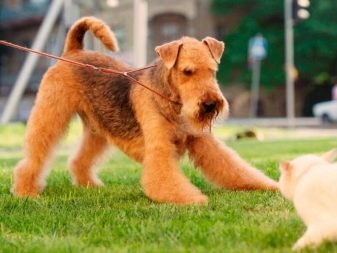
A distinctive feature of the dog is the increased rigidity of the coat - thick guard hairs are often compared to wire. The Airedale Terrier is adapted to survive in low temperatures - a soft and dense undercoat is hidden under the "wire" coat, which reliably retains heat. This dog has no total length of hair - depending on the part of the body, it can be longer or shorter, but it necessarily curly and curly.
A notable feature of the animal's appearance is the specific eyebrows, mustache and beard, formed from coarse hair.
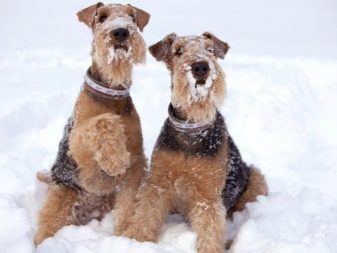
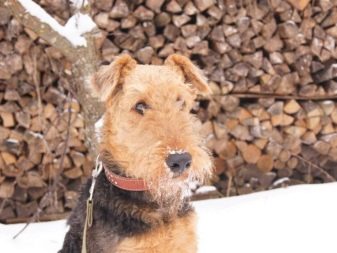
The standard allows for a certain variation in the color of the pet - it can be bright red or red-yellow, just yellow or brown, although the back always remains black. This color is usually called black-and-back. Wherein an important requirement is the uniformity of the "color" coloring - extraneous spots on the chest are still allowed, but they should be small and slightly affect the aesthetic perception of the individual.
At the same time, Airedale puppies from birth have strictly black fur, only as they grow older it is replaced by a more familiar one.
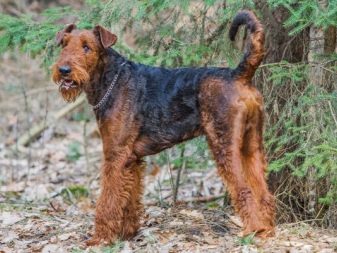

Character
Despite the fact that in its history the representatives of the breed sometimes had to solve very serious problems, the airedale is a cheerful dog, one of those who will gladly find an extra reason to have fun. A wise animal is meaningfully entertained by itself and can figure out that the owner needs to cheer up, at the same time figuring out how to do it.
Most often, such an energetic dog is a favorite of the whole family, including children, but it is noted that there are types of people with whom the character of the Airedale is incompatible. These include people who are too calm, harsh or tough - in a word, all those who do not support the pet's desire to have fun.
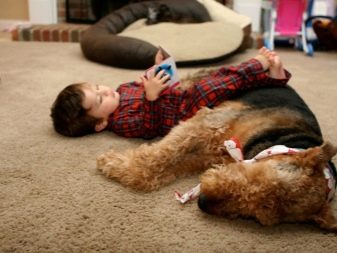
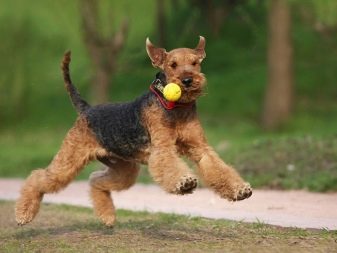
An intelligent dog is very attached to its owner, but does not create big problems for him - this is not a decorative doggie, which will defiantly "die" of grief every time the owner just left for work.
A properly raised dog will be glad to see the owner, but in his absence he will not go crazy. The dog is inclined to divide people into friends and foes - for the former they are very friendly and count on signs of favor on their part. At the same time, the animal is not inclined to servility - it obeys man, but is inclined to build relationships with the owner on the basis of relative parity.
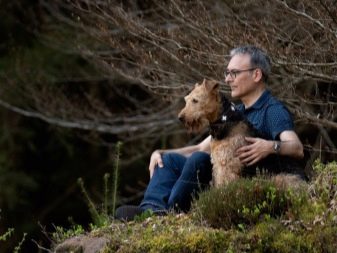
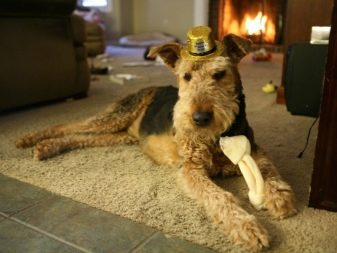
The hunting essence of the Airedale can create certain problems in ensuring that it can coexist normally with other pets. In most cases, the dog shows aggression towards cats, rodents and birds., for him they are prey, which must not only be driven out of sight, but must be caught up, killed and brought to the owner.
The only animals that the Airedale definitely doesn't fight with are other dogs, including his breeds. Nevertheless, a certain upbringing from early childhood can solve the problem - there are known cases of the dog's friendship with those whom he usually considers his hunting goal.
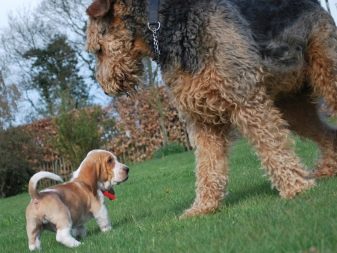

Aggressiveness (except for the manifestations of the hunting instinct) is not typical for the Airedale. He rarely initiates a fight, but peacefulness disappears if the aggression is directed at the dog itself. Representatives of this breed are vindictive, they remember their offender well. If a neighbor's dog offended the baby when he was a puppy, he will grow up and show signs of aggression towards the insolent person, who now himself would not risk provoking a mature opponent.
Situations like this happen quite often, and since many owners forget about past dog fights, they may have the misconception that airedale is a fighter who doesn't need a reason for a scandal.
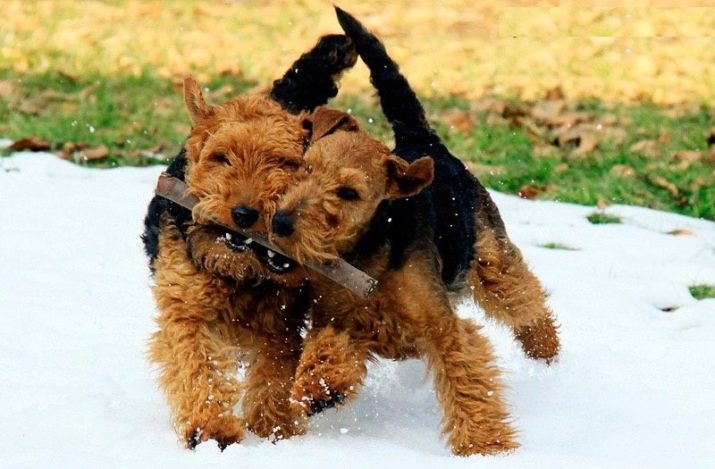
A dog's mental ability is largely assessed by how it interacts with children. The Airedale understands the difference between a child and an adult, he loves children and is ready to allow them a little more due to the fact that they can cause discomfort to the pet not so much out of malice as out of misunderstanding. At the same time, experienced owners advise not to leave the kids alone with the animal, but the reason lies not in aggression - just a large and rather active dog can accidentally push the little man, and he will fall.
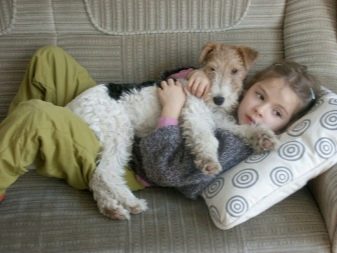
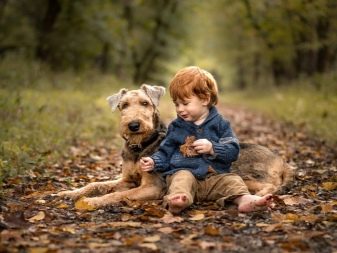
Life span
What the largest of the terriers cannot boast of is its longevity indicators. It is noted that the average life expectancy of representatives of this breed is only 10-12 years, and even then, subject to proper care and the absence of diseases. Although not considered particularly painful, Airedale Terriers are susceptible to several diseases that can shorten a dog's lifespan or make everyday life a pain.
One of the most common problems for Airedale Terriers is hip dysplasia, which is usually congenital in nature. The presence of such an ailment from early childhood is not always noticeable in a puppy, but sooner or later it will lead to severe dysfunction of the hind limbs, the dog may become disabled.
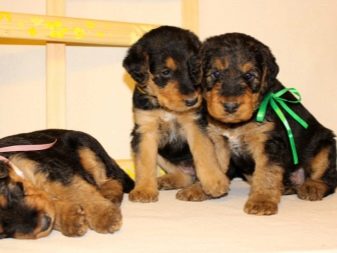
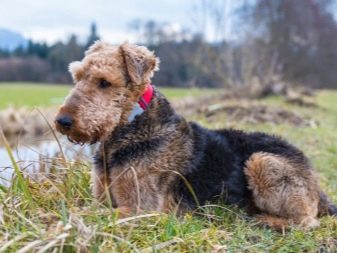
Of congenital diseases, it is also very dangerous von Willebrand disease - it is characterized by spontaneous bleeding, which does not contribute to the formation of a full-fledged, physically healthy individual. Many airedale diseases are acquired, the skin and eyes are most at risk. Unlike the above-described congenital ailments, such problems can at least be effectively dealt with.
Regular prevention and timely response to the first signs of a problem will help prolong the dog's life and protect it from any health problems.

Comparison with the welsh terrier
The Airedale Terrier is often confused with the Welsh Terrier - the two dogs are not only very similar to each other, but are also close relatives. Even those who clearly understand the difference between the two breeds are not always ready to immediately answer which of the two they would prefer. Let's take a look at the main differences between the two brothers.
- The key difference is that the animals were bred for different purposes. The generality of their appearance is due to the fact that both had a common ancestor - the Old English rough-haired black and tan terrier, but the breeders in the process of breeding both pursued different goals. The Welsh is a classic hunting terrier, which is obliged to climb into the hole for prey and fight with it there. This is the reason for the fundamental requirement that the height of the Welsh dog cannot exceed 40 cm.
Airedale, as we remember, is noticeably larger and does not climb through holes, but he has certain skills of a hound and can chase the beast on the surface.
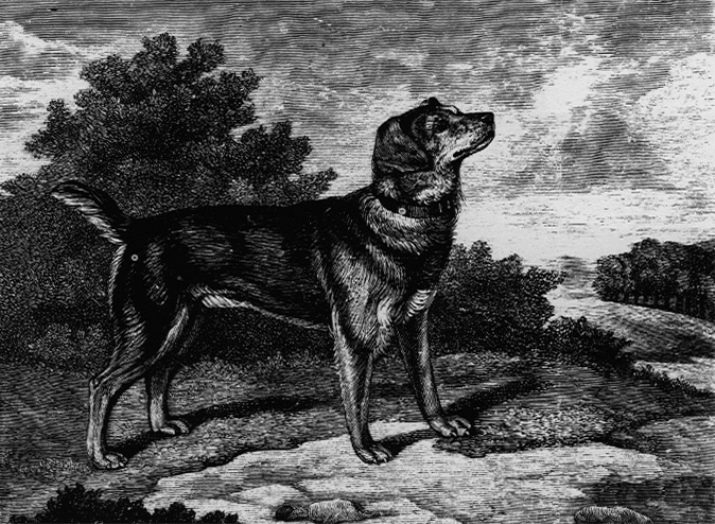
- Welsh terriers are sometimes mistakenly called a mini-version of Airedales, but this, of course, is a mistake - the differences lie not only in size, but also in proportions.... For example, on the body of a Welsh, the head stands out noticeably more - it seems larger in relation to the body than in the Airedale. Velsha's ears, unlike their counterparts, are directed, as it were, slightly forward. While it is customary for Terriers from the Eyre River Valley to glue their ears at a young age in order to correct their shape, then for the "Welsh" such a procedure is still a rarity.
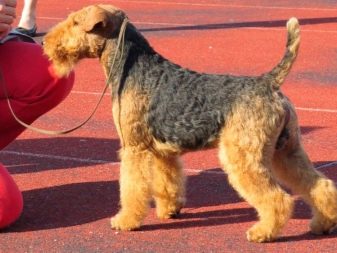
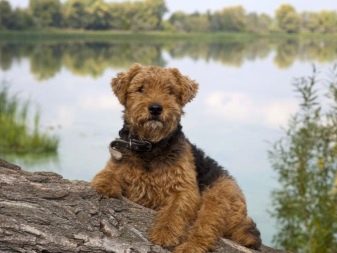
- In the descriptions of both breeds, it is indicated that the tail of the terrier should not be tucked under itself, but also should not be pressed against the back. Owners of dogs of different breeds treat deviations in tail position differently, which is caused by the already mentioned features of the original use of animals. So, for the Airedale, the position of the tail is not too important - it is docked and does not interfere in a fight, and for any practical purposes it is not used. Welsh relatives can still be used for hunting with penetration into burrows.
They need a standing tail so that it is convenient to pull the dog out of the animal's den, so a tail pressed to the back is not at all welcome.
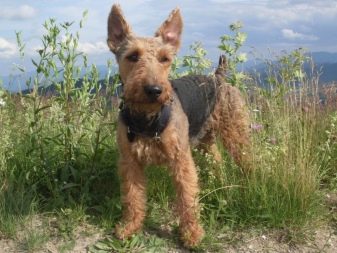
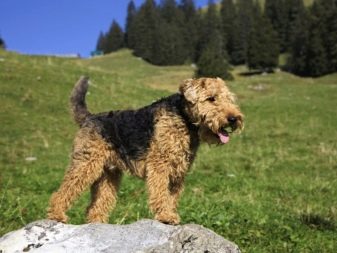
- Black-and-back coloration is common in both breeds, but unpainted hind legs are quite common among Welsh dogs. Since this is a completely typical feature, no one finds fault with it - it is considered a norm that does not contradict the standard. For the Airedale, such a feature of appearance is not a direct exclusion from the exhibition, but be prepared that you will not get points.
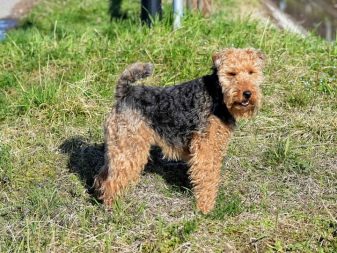
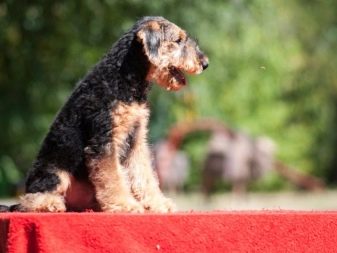
- Airedale terriers are famous for their coarse hair that does not require any maintenance, but occasionally there are individuals with an overly soft hairline, which is also called "sheep". For aesthetics, this could be a plus, but at dog shows, dogs are judged not for their desire to pet them, but for their ability to perform direct functions. Since the airedale is a hunting dog, soft fluff is absolutely useless for him - he will only get dirty and climb, so this is a clear minus for the individual. The welsh solves the problem radically - they simply are not suckers.
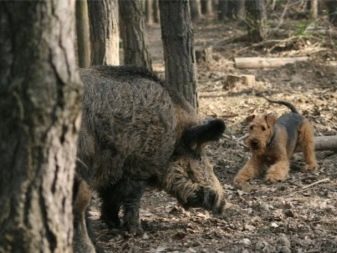

- Welsh terriers are often purchased by city dwellers, believing that in the conditions of a cramped apartment, a "reduced copy of the Airedale" will be just right. This is not entirely true - the compact dog is no less active than its larger brother, and in terms of cockiness it is even more daring, since it was specially taken out for tough battles in close conditions, where it is simply impossible to dodge an enemy attack. Welsh is constantly looking for adventures for himself, and he is also attracted by the fur clothes of the owners, in which he, what good, can smell the prey.
The difference in the behavior of the two dogs is especially noticeable on the hunt - the Welshman desperately rushes into the thick of the fight, completely not thinking about the consequences for himself personally, while the Airedale, faced with a superior enemy, tries to choose the tactics of small bites and attracting the owner's attention.
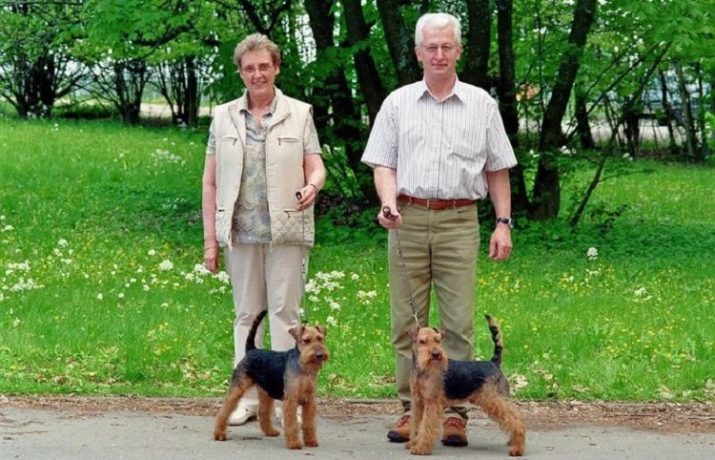
Features of maintenance and care
Despite its rather large dimensions, the Airedale is well suited for home keeping, even in a city apartment, not to mention a country house with at least a small garden plot. A properly raised dog does not create problems for its owners, behaves quietly and correctly.
An additional advantage of choosing in favor of representatives of this particular breed is also the fact that the wire-haired pet practically does not shed, which means that it creates fewer reasons for the development of allergies. However, animal saliva or dandruff can still replace the dog's hair as allergens.
Terriers from the Ayra Valley are not devoid of a warm undercoat, but in the case of year-round keeping on the street in our conditions, care should be taken to insulate the dwelling for the dog - for this it is necessary to build a capital booth or design an insulated enclosure. The animal can be used as a reliable guard dog, especially if a particular individual has been specially trained to do this since childhood.
At the same time, we must not forget that the pet is very curious and not devoid of a hunting instinct - if the animal is not limited, it may well engage in pioneering activities and chase neighboring dogs, cats and other animals.
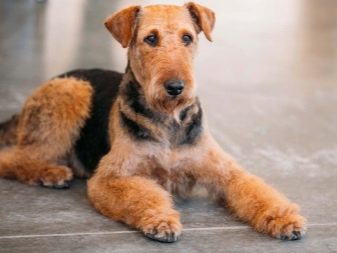
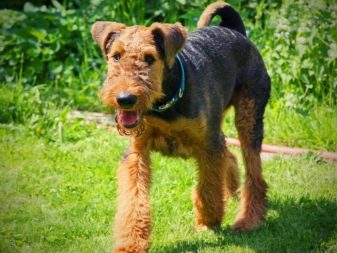
Airedale was created for long-term pursuit of the goal, therefore it is unusual for him to sit still for a long time - the animal loves prolonged physical activity and needs regular walking. This is not a chain dog, a walk strictly at a distance of a leash by a pet will not be counted - seizing the moment, the pet will simply run away to get the desired space. Experienced owners advise it is imperative to release the Airedale Terrier from the leash, once in a suitable place - where the dog will not get involved in a fight with any animals.
So that the pet is not overly carried away and does not run away to an unattainable distance, it should be kept at a short distance with periodic calls. To make it interesting for the dog too, it is necessary to treat her with something during such short meetings.
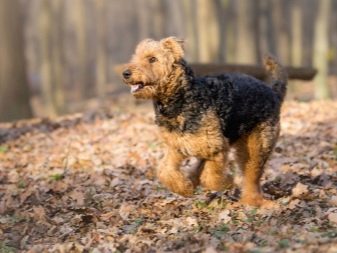
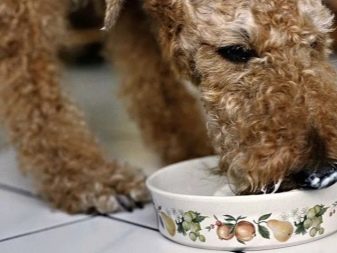
The statement that the harsh coat of the airedale terrier does not need any maintenance at all - a kind of myth. Of course, caring for this breed is a little easier than for decorative smooth-haired dogs, but the same combing should not be completely ignored, because otherwise the development of one of the many potentially dangerous skin diseases is possible. Since the airedale does not have the characteristic canine scent, it is not necessary to bathe it regularly.
Molting is not typical for this species of terriers, but the hairs in their coat are also capable of periodically withering away. Trimming, that is, removing dead hairs, should be done relatively rarely - once every 3–6 months.
Some owners master this process on their own and perform a similar duty without outside interference, but if you doubt your abilities, you can put the dog in the hands of specialists - they will do their job correctly, quickly and without unnecessary discomfort for the patient.
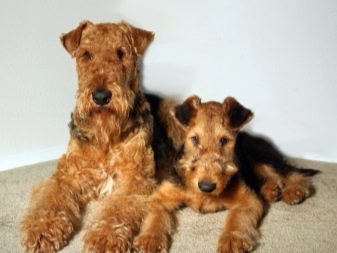
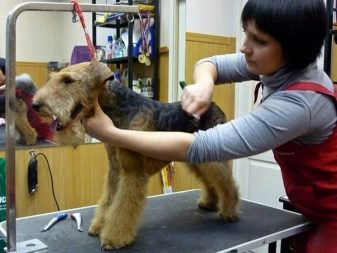
Please note that in the summertime the coat of the Airedale Terrier can give the dog some discomfort, so it would be reasonable and humane to cut it. This is usually done according to a scheme that allows you to preserve the characteristic features of the animal's appearance. If all hair is cut relatively short, then the beard and mustache are neatly trimmed so that the thoroughbred dog remains himself.
On the contrary, it is undesirable to carry out a haircut before the cold and long Russian winter, since representatives of this species do not differ in their ability to withstand low temperatures. Moreover, for walking along the street, a blanket will not interfere with a pet, allowing at least a little to warm the body.

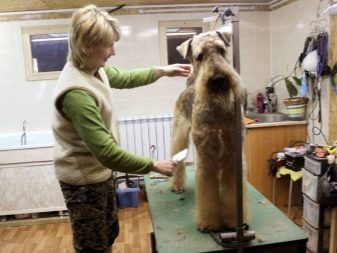
The purebred English dog is not among the most susceptible to various acquired diseases, but it is better to take care of yourself once again and engage in constant prevention of major diseases. Examination of the eyes, ears and mouth is not done daily, as would be the case with decorative dogs, but once a week the owner is simply obliged to find time for this.
Cleaning your ears and teeth is also not needed every day, but such procedures will have to be performed as needed. - usually this happens at a time when enough sulfur has collected in the ears, and a characteristic plaque has appeared on the teeth. At the same time, almost the only duty from which the owners of the Airedale are exempted is trimming the claws, although this condition is met only if the pet does not lack regular exercise.
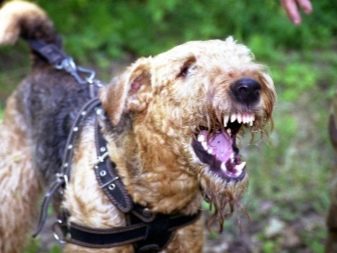

Feeding
The energetic behavior of the Airedale requires constant feeding of calories, while the menu must be balanced so that the fit and athletic dog does not turn into a barrel. You can feed your pet with both dry store food and natural products. In both cases, it makes sense to preliminarily consult a veterinarian - he will tell you which food to choose and how to create a balanced program that includes a sufficient amount of proteins, fats and carbohydrates, as well as essential vitamins and minerals.
As befits a predator, the basis of the diet for the Airedale is meat and offal. It is not necessary to boil such a product, but it is advisable to cut it into pieces of such a size that the animal does not have to gnaw them. When choosing a type of meat, try to give preference to lean varieties, such as chicken, beef, or rabbit.
Meat can and should be periodically replaced with fish, but not any - you should choose only seafood.
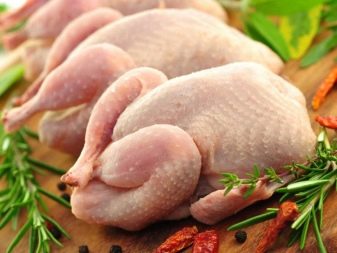

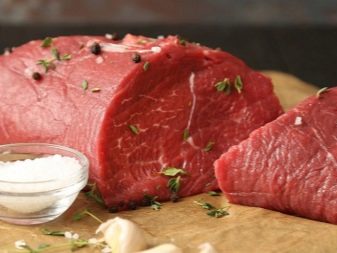

It is impossible to feed such a large dog with meat alone, and it makes no sense - the dog also needs a side dish as a source of carbohydrates. As such, it is necessary to use buckwheat, oatmeal or millet; it is better not to experiment with the rest of the cereals. Fermented milk products cannot be considered the basis of a dog's diet - they appear there relatively rarely and in small quantities, but there must be a place for them.
Here, too, you should not give everything in a row - it is advisable to limit yourself to cottage cheese and kefir. Sometimes it makes sense to give a boiled egg - it contains a lot of useful things. Vegetables and fruits are also needed by Airedale Terriers; some varieties of plant foods are very much loved by these dogs.
From garden products, pumpkin, carrots and beets should be given, from fruits, apples are almost the only available option.



A completely separate topic - products that, in principle, should not be given to airedale. In principle, this list is about the same for all dogs, but you should go over it once again to avoid common mistakes and prevent possible problems with the health of the digestive system in your pet. For everything to be in order, it is highly undesirable to give him the following types of products:
- fatty meat - primarily pork, but also lamb, smoked meat and fish, as well as products from them;
- any sweet food, including baked goods, chocolate, confectionery;
- spicy and spicy foods, including onions and garlic;
- citrus fruits in any form;
- pasta.



If, in the case of an adult, the owner is free to choose what to feed the pet - natural products or dry food, then in the case of puppies, emphasis should be placed on an independently compiled menu, while dry food is added gradually and only as the young grow up. note that young airedale terriers eat a little, but often - they are advised to feed them approximately 5-6 times a day.
Chewing activity is especially difficult for a small doggie, so the owner must make sure that the food has a consistency close to mashed potatoes, while it is best to focus on the room temperature of the food. The transition to an adult diet occurs gradually - at about six months of age, the Airedale can be fed only four times, and from eight months of age - only twice a day. Remember that the animal is growing, so reducing the number of meals should inevitably lead to higher dosages.
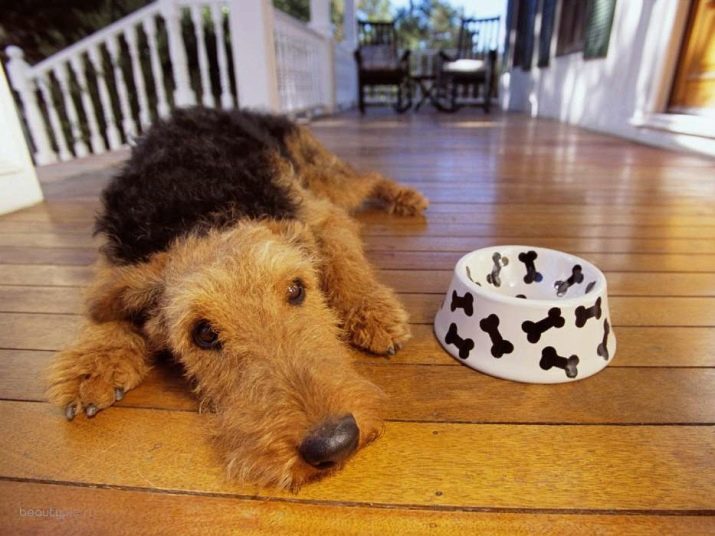
Upbringing
The Airedale is smart and quick-witted and can be trained well, but the logic that works for most dogs will not work here. Representatives of this breed are very headstrong. If there is no desire to learn, it will not work to force the dog - it is not even afraid of physical punishment, and an attempt to bribe a pet with treats will be perceived as a spontaneous treat without any action in response.
The problem is It should be interesting for a pet to study, if from childhood he has not been accustomed to training, even an experienced trainer will no longer be able to remake him. Obedience and servility are not at all typical of the curly-haired four-legged, so it will find a way to evade training.
To achieve the desired result, a person should start working with a puppy from an early age and push on the passion that is inherent in any Airedale from birth.

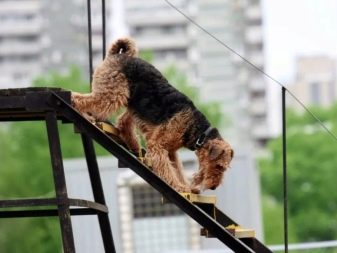
A common mistake homebrew trainers make is repeating the same command over and over again. Representatives of this breed are very smart and grab new knowledge literally on the fly, but repeating a long-learned exercise quickly bothers them, they stop responding to the command. Of course, the dog sometimes needs to be reminded of certain exercises, but this should happen less often than with other dogs.
Build your workout so that it does not look the same type and worn out, But do not worry about the fatigue of the animal - it is extremely difficult to tire the Airedale Terrier.
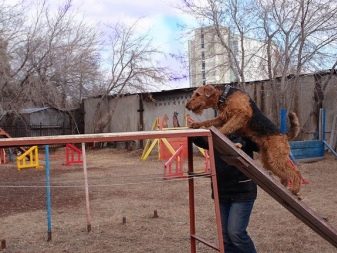
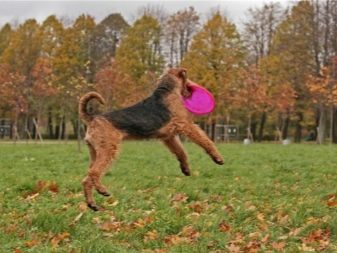
The dog instinctively loves to explore the surroundings and seek adventure for itself, so it is important to teach him that a leash is a duty that cannot be ignored. At the same time, you need to regularly give the dog the opportunity to let off steam - find an opportunity to go with the dog to a place where it can be released on all four sides. Knowing that the hour of the walk will come, the pet will behave more disciplined and will not run away from the leash.
At the same time, be prepared for the fact that this dog grows up at about two years old - before that, it often behaves irresponsibly.

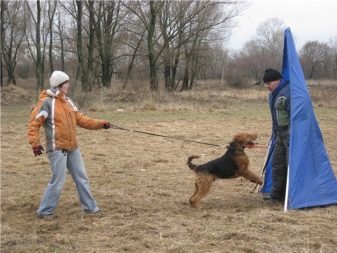
The Airedale is exactly the dog that can and should be taught to serve, because such a pet is well suited for the needs of protecting the territory and protecting it from any outside encroachments. Experts pay attention to the fact that the moment must not be missed while the young puppy is still amenable to education, so if any misunderstandings arise in your communication with the pet, do not expect the problem to be solved by itself - contact a professional dog handler, who is still manages to teach the baby. When the appropriate age for learning has passed, the dog will become as self-willed as possible, so it will no longer be possible to dictate his conditions to him.
From all of the above, one could make the erroneous conclusion that raising an Airedale Terrier is a difficult and thankless task, so it’s not worth having such a dog at all. It is only partly true - you really have to tinker with the animal, but with the right approach and sufficient patience, you can grow a loyal furry friend from a baby, which will delight not only with its own cute appearance, but also with devotion, as well as the performance of guard or hunting functions.
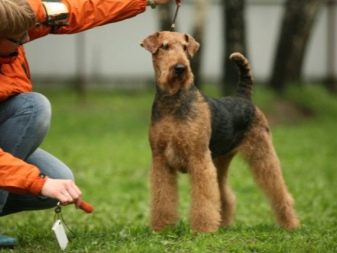
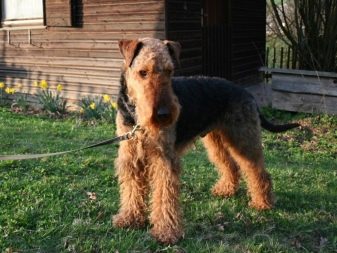
Popular nicknames
The Airedale is an active dog, and the owner's task is to make sure that the pet quickly responds to requests addressed to him. For this reason experts advise to call the dog short and sonorous - so that you yourself do not get tired of calling her repeatedly during the day. Some owners prefer to invent a nickname for their dog on their own - this is original and allows you to reflect the tastes of a person on his dog.
In such cases, inspiration is usually drawn from literature or mythology, the beast is named after real-life people, or even just a melodic nickname is invented. This approach has a right to exist, but not every person's fantasy works well enough to make the name really fit a curly dog.
In this situation, it would be most reasonable to check what other dog breeders call similar dogs, fortunately, there are enough tips on this topic on the Internet.
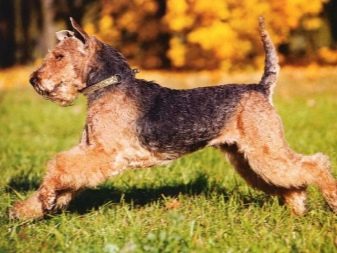
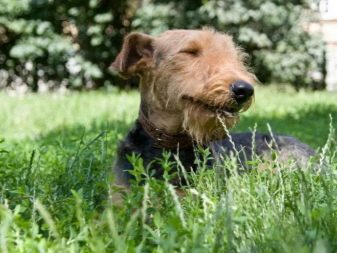
If you have a bitch, look for foreign female human names first. Options such as Bessie, Greta, Gina, Lyme or Helga, fit the dog very organically - her heightened curly look goes well with a reference to celebrities with whom such names are associated.Often they look for inspiration in ancient legends, thanks to them nicknames like Vesta or Lyra.
Of a purely domestic prevalence, only Haze, but this name quite accurately describes the appearance of the pet.
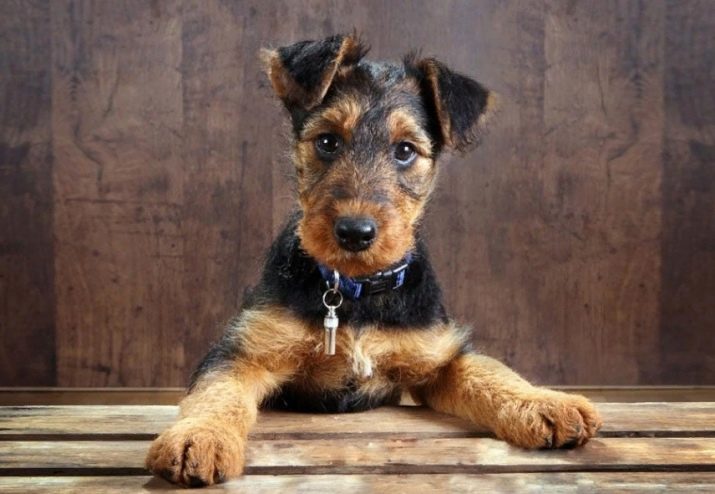
The list of nicknames for males is even wider - any foreign names that are at least a little associated with aristocracy, like Glen, Ethan, or Richard. However, not everyone is chasing the sublime - the "common people" will also descend. Ike, Bob, Johnny, Kim, May, Pete, Teddy or Frank. For the unrestrained activity of Airedale boys, they are often called Typhoons, and in the Black Sea region it is popular to call them also Scythians, emphasizing the independent and nomadic character.
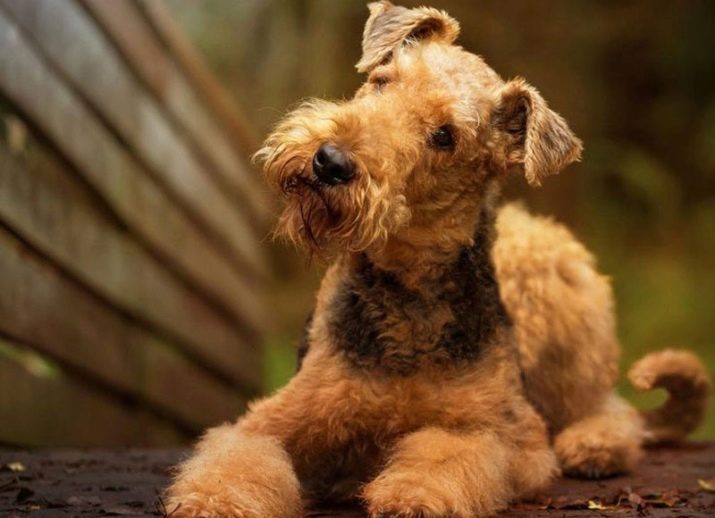
Owner reviews
Almost any Airedale owner will confidently tell you that there is no better dog than his pet. This is not such a subjective opinion, because intelligence and ingenuity for the Airedale are innate and well-developed traits, and timely correct upbringing allows you to turn the dog into an ideal that will come in handy in any situation. For an amateur dog lover, this is an excellent companion, for the owner of a personal plot - a reliable guard and protector, for a hunter he will also become a loyal companion.
The outstanding personal affection of an intelligent animal for its owner is exactly what people domesticated the dog for many thousands of years ago. Of the obvious disadvantages attributed to the representatives of this breed, one can single out only the willfulness and the desire to hunt literally everything that moves. In fact, both problems are solved by timely education.
If the future owner inquired in advance about the peculiarities of the breed before buying a puppy, he simply will not face a similar problem.
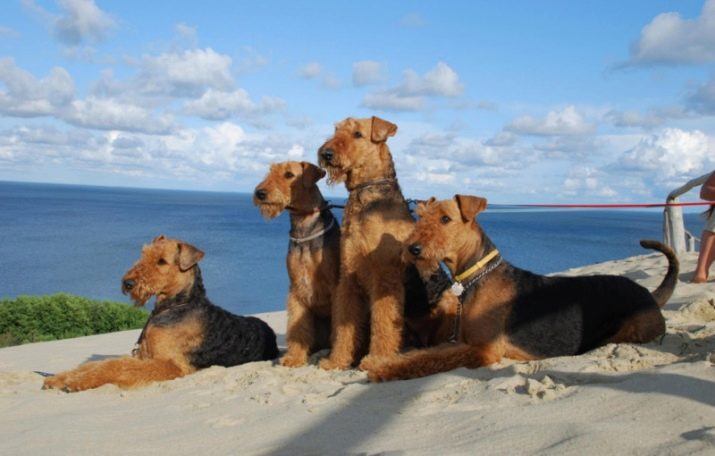
For the characteristics of the breed, see the following video.






































